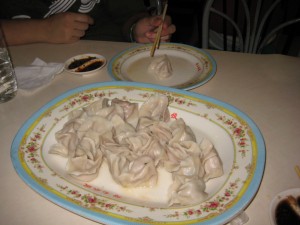Dumplings (饺子) Posted by Stephen on May 30, 2012 in Uncategorized
 A fellow 老外 studying abroad with me in China once said that “A man can live off of dumplings and beer alone, and it ain’t a bad existence”. True words probably haven’t ever been spoken.
A fellow 老外 studying abroad with me in China once said that “A man can live off of dumplings and beer alone, and it ain’t a bad existence”. True words probably haven’t ever been spoken.
For a mere 十快 (shí kuài)-that’s a little under two us dollars- you get everything you need. The holy trifecta of meals: cheap, delicious, and easy to eat. They are the perfect food. Gloriously satisfying and easy on the wallet.
Dumplings may be Chinese Foods’ greatest secret. It makes you wonder why dumplings aren’t served everywhere in the world. I’m amazed McDonalds doesn’t have a 10 piece McDumpling Meal.
Enter the Dumpling:
What are these delicious pouches of ground-up meat, vegetables and starch? Why are they so cheap and yet so fantastically good?
Dumplings or 饺子 (jiǎozi) are one of China’s most recognizable and historical food stuffs, synonymous with luck or 幸运 (xìngyùn), good fortune or 时运 (shíyùn) and happiness or 幸福 (xìngfú). While traditionally a dish eaten during holidays, celebrations and festivals, 饺子 have evolved into a staple of every day life in China and range from fast food to go boxes, to fine dining, multiple course meals.
Watch how to make your own dumplings here:
http://www.youtube.com/watch?v=P4sit7MT1kM&feature=related
You are what you eat
Much like 串儿 (chuàner),dumplings are comfort food, all wrapped up in a neat little package in bite-size form. They travel well, keep well and are entirely self-contained. As a result, they can be found on almost any street corner or in any hole-in-the-wall restaurant. The trick is finding a place that specializes specifically in dumplings, which is rather easy so long as you recognize the characters for it.
Why so prevalent? The reason for this is simple: “dumpling folk” take pride in their work, and over decades (if not centuries) have mastered the exact proportions and specific mixtures of ingredients that maximizes complimentary tastes within these palatable pouches. The dough must be thin enough to not infringe on the flavorful filling, yet thick enough not to fall apart. It may look easy to make, but a true dumpling is a culmination of years of practice and experimentation (believe me, I made dumplings with my host family and they were mediocre at best).
Variety: the spice of life
But the real reason why dumplings are king is the variety, both in filling and in preparation. Aside from the basic steamed 饺子, there are a plethora of cooking variations used namely: fried dumplings 炸(zhá)饺子,pot stickers (锅贴儿 guōtiēr), boiled dumplings (水饺 shuǐjiǎo), shumai (actually pronounced shāo mài or 焼売) and even dumplings with sauce and juices inside, much like 小龙报 bào (a personal favorite). Once you’ve decided upon how to cook your dumpling, you then you have pages and pages of options of filling to decide amongst, including every imaginable meat, seafood, or veggie mixture in the Chinese cookbook.
Some Examples:
猪肉白菜-Pork and “Cabbage”
牛肉青菜-Beef and leek
小龙包-A mixture of animal stock broth, pork and bamboo shoots
How to eat:
Eating dumplings is pretty straightforward. All you really need is some basic chopstick skills, a side plate and some dipping sauce that you make yourself. This is my favorite part of a dumpling feast and really lets you add your own special flavor to the meal.
When eating dumplings, you will have a small side plate to mix your sauce in. Most restaurants provide vinegar or 香醋 (xiānɡcù), spicy pepper sauce or 辣椒 (làjiāo), and garlic cloves or 大蒜 (dàsuàn), for you to mash, mix and stir into your plate. This dipping sauce is entirely your call, so you can play around with your palate finding the perfect blend of sweet, spicy, savory and sour.The only tricky part is making sure your dumplings don’t belly flop from your chopsticks into the plate, spraying everyone at the table with your vinegary concoction (my 老外 friend was an expert in spattering the table with his super spicy mixture-every time).
When you order dumplings, you often order by weight, instead of quantity. Sizes are usually half a kilo 半公斤 bangōngjīn for a plate or 一盘 (yipán), or for those “starving to death” or 饿死了(èsǐle), the full kilogram or 公斤. Just be mindful of how many of these guys you eat, otherwise you’ll start looking like a stuffed 饺子 yourself.

Build vocabulary, practice pronunciation, and more with Transparent Language Online. Available anytime, anywhere, on any device.
About the Author: Stephen
Writer and blogger for all things China related. Follow me on twitter: @seeitbelieveit -- My Background: Fluent Mandarin speaker with 3+ years working, living, studying and teaching throughout the mainland. Student of Kung Fu and avid photographer and documentarian.




Comments:
lixiaoming:
I like dumplings.
Sieru:
What perplexes me is why they are so expensive here in the States. Whether they’re being bought at a food stand, restaurant, or frozen food aisle, I consistently avoid them because they are expensive.
A:
Really good ones at Teatone in Andover MA.